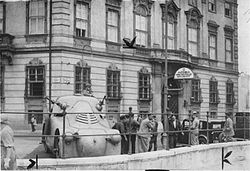
Back انقلاب يوليو Arabic Мангалан беттан карчам CE Červencový puč Czech Juliputsch German Golpe de Estado de julio (Austria) Spanish Putsch de juillet French Golpe de Estado de xullo (Austria) Galician פוטש יולי HE Upaya kudeta Juli ID Putsch di luglio Italian
| July Putsch | |||||||
|---|---|---|---|---|---|---|---|
| Part of the interwar period | |||||||
 Police car at Ballhausplatz outside the Chancellery building in Vienna, 25 July 1934 | |||||||
| |||||||
| Belligerents | |||||||
|
Supported by: |
Supported by: | ||||||
| Commanders and leaders | |||||||
|
Fridolin Glass Otto Wächter Anton Rintelen |
Engelbert Dollfuss † Wilhelm Miklas Kurt Schuschnigg Ernst Rüdiger Starhemberg Emil Fey | ||||||
| Strength | |||||||
|
154 SS (Vienna) thousands (elsewhere) | Entire Federal Army, police, gendarmeries, and paramilitary Heimwehr forces | ||||||
| Casualties and losses | |||||||
|
98[1]–140[2] killed 13 executed[2] 4,000 detained[2] | 101[1]–104[2] killed | ||||||
| 11[1]–13[2] civilians killed | |||||||
The July Putsch (German: Juliputsch) was a failed coup d'état in Austria against the Fatherland Front government of Engelbert Dollfuss by Austrian Nazis from 25 to 30 July 1934.
The Austrian Legion and German Schutzstaffel soldiers with support from Nazi Germany attempted to depose Dollfuss's Austrofascist regime in favor of a pro-Nazi government under Anton Rintelen of the Christian Social Party. The Nazis attacked the Federal Chancellery and assassinated Dollfuss, but the majority of the Austrian population and the Austrian Army remained loyal to the government. The July Putsch ultimately failed when Adolf Hitler withdrew his support for the coup after Fascist Italy guaranteed to diplomatically support Austria against a German invasion.
The Austrian government eventually suppressed the coup, with over 200 people being killed in six days of fighting. A number of Austrian Nazis and collaborators were charged with treason and executed or imprisoned. Kurt Schuschnigg succeeded Dollfuss as Chancellor of Austria and the Fatherland Front remained in power under the Federal State of Austria until the Anschluss in 1938.